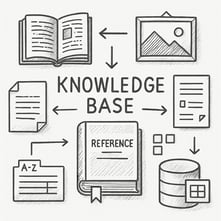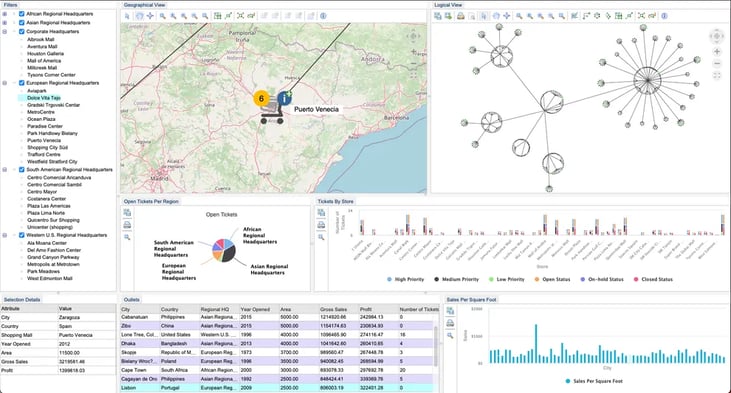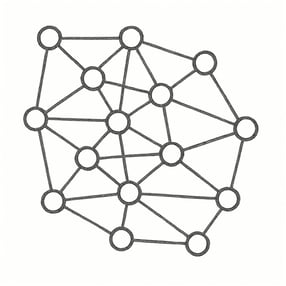Understanding the distinctions between structured data systems, such as databases, knowledge bases, and knowledge graphs, is essential for anyone working with information in engineering, research, content management, or data architecture. While these terms are sometimes used interchangeably, they represent fundamentally different models of organizing, storing, and retrieving knowledge.
This article offers a focused comparison that clarifies what a knowledge base is, how it differs from a knowledge graph and a database, and when each is the most appropriate solution. The goal is to provide value to both those newly exploring these systems and to experienced professionals seeking more profound conceptual clarity and practical guidance.
What is a Knowledge Base?
A knowledge base is a structured system designed to store and retrieve information, typically focused on a specific domain or set of topics. It is often used to centralize institutional or organizational knowledge, allowing users to access answers, documentation, or explanations without relying on human intermediaries. The content within a knowledge base is usually written and curated by subject matter experts, technical writers, or support teams, and is organized in a way that prioritizes clarity and accessibility.
Knowledge bases are commonly used in customer support, product documentation, internal training, and technical reference systems. The information they contain is usually organized in a way that anticipates user questions or problems, presenting structured content such as how-to guides, FAQs, procedures, and definitions. They typically support keyword-based search, categories, and sometimes tagging, to enhance findability. Often, knowledge bases collect and store information that come in a wide variety of formats.
 |
While many knowledge bases are static and rely on manual updates, more advanced implementations integrate user feedback, analytics, and editorial workflows to ensure that the information remains current and relevant. With the advent of large language models (LLMs), knowledge bases may provide more free-form question and answer user interactions, but these are based on the underlying texts or data. |
What is a Knowledge Graph?
A knowledge graph is a model for representing knowledge through entities and the relationships that connect them. Unlike a traditional knowledge base, that organizes information in a document- or article-centric way, a knowledge graph structures knowledge as a connected network. Each node represents a real-world entity or concept, while edges define the relationships between them.
This structure allows the system to reason about data, infer new relationships, and retrieve information in context. The goal is not only to store facts, but also to model meaning so that machines can interpret it semantically. This is made possible through ontologies, taxonomies, and standardized vocabularies that define how concepts relate within a specific domain.

Simple knowledge graph showing three related persons and other details. The connections in a knowledge graph have meaning, like the difference between a sister and a spouse.
Knowledge graphs can contain literal values like dates, references to other complex connected objects, and references back to types defined by an ontology (human).
Knowledge graphs are well-suited for systems that require disambiguation and contextual understanding. They are also effective when integrating data from multiple heterogeneous sources. In contrast to keyword-based retrieval, which may return documents that simply contain a term, a knowledge graph can deliver precise answers by understanding how entities are connected.
Knowledge Base vs Knowledge Graph: Core Differences
The primary distinction between a knowledge base and a knowledge graph lies in how each system represents and manages knowledge. A knowledge base stores information as structured text, often grouped by topic or question, and optimized for human readability. It is designed to provide answers, guidance, or explanations in response to specific queries, often through keyword-based search.
A knowledge graph, by contrast, focuses on the relationships between pieces of information. It represents data as a graph structure, where nodes correspond to entities such as people, organizations, or concepts, and edges represent the relationships between them. This model enables more dynamic and flexible querying because it reflects not just what entities exist, but how they are contextually linked.
Another key difference is how each system handles reasoning. A knowledge base relies on predefined content and does not infer beyond what is written. A knowledge graph, depending on its design, may support inference by using logical rules, semantic relationships, or external data sources to derive new facts from existing ones.
The two systems also differ in their adaptability. Knowledge bases tend to be more rigid and require manual updates. In contrast, knowledge graphs are often built to evolve, allowing for the easier integration of new data sources and the real-time enrichment of information.
Finally, from a user interaction perspective, a knowledge base typically returns entire articles or documents in response to a query, whereas a knowledge graph can support direct answers and granular data retrieval through semantic search.
A knowledge base might provide the needed details to populate a knowledge graph. While a knowledge graph might provide a more dynamic way to index, link, and infer about related information that is locked within a knowledge base made of documents. They perform vastly different functions that can be complementary.
A knowledge base might be indistinguishable from any web site you visit. You can navigate and ask questions with the tools they provide, and the results may be entire documents, or other pages. A knowledge graph, however, is a way to structure data for processing. Some tools let you navigate a knowledge graph using diagrams and links.

|
|
| Web sites are the knowledge bases that most of us use every day. |
Knowledge graphs represent facts connected in specific ways. |
Consider any technical manual you have ever consulted when the lawn mower or your car malfunctions. The answer you need might be somewhere in that knowledge base we call a user manual, but you need the index to find it quickly, and you need the author's helpful cross references to answer related questions that are part of another section, which is like a knowledge graph. Both knowledge bases and knowledge graphs are far more capable than your owner's manual, but they both grew out of the need to communicate and connect what we know so we can find and use information when we need it.
Knowledge Base vs Knowledge Graph: Side-by-Side Comparison
Data Structure
A knowledge base typically relies on hierarchical or categorized storage of information. Content is organized by topic, keyword, or issue type and can be accessed through search or navigation menus. Each unit of knowledge, such as an article, answer, or guide, is generally treated as a standalone object, even when it references related materials. These packets of knowledge are often tagged with meta-data so that they can be categorized according to the design of the knowledge base.
In contrast, a knowledge graph uses a graph-based model to structure data. Rather than treating each unit of knowledge as an isolated block, it decomposes information into discrete entities and defines the relationships between them. This enables the graph to reflect the interconnected nature of knowledge. Data in a graph is stored as triples: subject, predicate, and object, which creates a flexible schema and supports non-linear navigation and complex querying.
Relationship Modeling
In a knowledge base, relationships between topics are often implicit. A document may reference another article, or related content may be suggested based on tags or manually created links. However, these relationships are not modeled as structured data. They exist primarily to aid human understanding rather than to support computational logic.
A knowledge graph, on the other hand, is defined by its explicit modeling of relationships. Every connection between entities is formally described using a defined schema or ontology. These relationships are not merely contextual; they are machine-readable, queryable, and logically structured. For example, a knowledge graph can represent that "Company A acquired Company B in 2021" as a first-class data element, enabling systems to reason over this information without relying on natural language interpretation.
This explicit modeling allows knowledge graphs to support more advanced operations, such as semantic search, inference, and disambiguation. It also makes them inherently more suitable for integration across data silos, since the relationships provide structure that bridges disparate sources.
Flexibility and Use Cases
A knowledge base is often designed with a fixed structure. Its architecture is typically determined by the domain it serves, such as customer support, IT documentation, or internal knowledge sharing. Once deployed, it tends to evolve slowly, with updates handled manually and scoped within predefined categories. This makes it stable and predictable, but limits its adaptability to new or changing information without direct editorial intervention.
Use cases for knowledge bases typically center on delivering static answers to recurring questions, guiding users through troubleshooting steps, or providing standardized reference materials. These systems work well in environments where the information changes infrequently and where users are seeking clear, human-readable explanations.
A knowledge graph, by contrast, is more dynamic. Its structure allows new entities and relationships to be added without requiring a redesign of the system. Because connections rather than categories drive it, it can absorb and organize unstructured or semi-structured data more easily. This flexibility makes it well-suited for environments where information is constantly growing or evolving, and where systems must respond to changes in context, scale, or data sources.
Knowledge graphs are frequently used in recommendation engines, search optimization, digital assistants, biomedical research, and AI applications that require contextual understanding and reasoning. They are especially valuable when working across domains or integrating multiple sources of knowledge that need to be unified into a single, coherent model.
When to use a Knowledge Base vs a Knowledge Graph
Choosing between a knowledge base and a knowledge graph depends on the nature of the information being managed and the goals of the system that uses it. A knowledge base is best suited for scenarios where the objective is to provide direct, structured answers to known questions. If the content is relatively static, easy to categorize, and intended primarily for human consumption, a knowledge base provides a clear and maintainable solution.
In contrast, a knowledge graph is suitable when the information domain involves complex interdependencies, frequent changes, or the need for more sophisticated computational reasoning. Because it can encode both data and semantics, a knowledge graph enables systems to go beyond surface-level retrieval and instead return context-aware insights.
For example, if an organization needs a searchable portal for internal policies or user guides, a knowledge base is often sufficient. However, if the same organization wants to integrate product data, customer interactions, and support outcomes to power recommendations or automate decisions, a knowledge graph becomes more effective.
It is also worth considering the scale of data integration. Knowledge graphs excel in environments where information must be linked across systems or departments, whereas knowledge bases perform well when the content is centralized and uniformly formatted.
It may be useful to consider how a wiki, a highly connected digital knowledge base, can only answer questions that someone (usually a human) has deliberately cross-referenced based on other available wiki page topics or other referenced works. Going back to the user manual example, a wiki is a really great user manual with easy to use cross-references that take you to the next section you need to read to solve your problem. However, it doesn't have any capability to interpret the information semantically to provide more cross references that could be more effective for the problem you are solving; that requires a knowledge graph.
Database vs Knowledge Base: What's the Difference?
Definitions and Roles
A database is a general-purpose system designed to store, retrieve, and manage data in a structured format. It serves as the foundational layer for countless applications, supporting everything from transaction processing to analytics. The structure of a database is governed by a schema that defines tables, fields, data types, and the relationships between them. Access is typically performed through query languages such as SQL, and the system ensures integrity, consistency, and performance at scale.
A knowledge base, by contrast, is a curated repository of information designed to help users find answers or gain a deeper understanding of specific topics. It is content-centric rather than data-centric. While a database stores raw values such as names, dates, or identifiers, a knowledge base contains explanatory content, including documents, articles, definitions, and procedures. It is often built on top of a database or content management system, but adds layers of interpretation, navigation, and contextual relevance.
The role of a database is to manage structured data efficiently, often as part of a backend system. Databases need to be dependable, predictable, and efficient for fast and efficient processing. The role of a knowledge base is to surface knowledge in a way that is understandable and actionable to humans. Knowledge bases are designed for human accessibility rather than fast computation.
Structural Differences
Formal schema constraints define the structure of a database. Data is organized into tables with rows and columns, where each column has a specific data type and function. Relationships between data elements are established through keys, including primary and foreign keys, and enforced through normalization rules. This model is optimized for consistency, speed, and scalability, particularly in systems that require precise data handling, such as finance, inventory, or user management.
A knowledge base, however, is structured around user comprehension rather than strict data constraints. Its organization is typically thematic or topic-based, instead of enforcing rigid relationships between atomic data points, a knowledge base clusters related information into coherent entries or documents. The structure is guided more by information architecture principles than by data modeling logic.
While a database ensures that each field contains valid data and supports operations like joins or aggregations, a knowledge base emphasizes discoverability, readability, and information flow. Internal linking, tags, and content hierarchy replace relational joins as the primary means of navigating between topics. The structure is looser by design, allowing for flexibility in how concepts are presented and accessed.
How Databases and Knowledge Bases Work Together
Although databases and knowledge bases serve different functions, they are often used in combination to deliver complete and responsive information systems. A knowledge base can rely on a database as its underlying storage layer, using it to manage the content, metadata, user permissions, and analytics that support the delivery of knowledge articles. In such cases, the database acts as the operational backbone, while the knowledge base provides the interpretive and user-facing layer.
In more advanced implementations, a knowledge base may dynamically generate content by pulling structured data from a database and combining it with templated explanations or visualizations. For example, a technical support system might pull configuration details from a customer database to customize troubleshooting instructions for that specific user scenario.
This interaction allows organizations to leverage the strengths of both models. The database ensures accuracy, scalability, and transactional integrity, while the knowledge base provides context, meaning, and usability. Together, they bridge the gap between raw data and human understanding, supporting both backend processing and front-end knowledge delivery.
Knowledge Base vs Database vs Knowledge Graph: Full Comparison Table
The distinctions between these systems are most evident when compared side by side across attributes such as structure, purpose, scalability, and use cases.
|
Feature / Dimension |
Database |
Knowledge Base |
Knowledge Graph |
|
Primary Purpose |
Store and retrieve structured data |
Provide curated content to answer questions |
Model relationships and enable semantic understanding |
|
Structure |
Tables, rows, columns (schema-based) |
Topic-based articles or documents |
Graph of entities and relationships (triples) |
|
Optimized For |
Data integrity, performance, scalability |
Human readability, clarity, navigation |
Contextual reasoning, inference, integration |
|
Query Language |
SQL or NoSQL |
Keyword search, tags, navigation |
SPARQL, graph queries, semantic search |
|
Best Used When |
Transactions, reporting, backend systems |
Documentation, FAQs, support portals |
AI applications, search engines, and data integration |
|
Relationships Handling |
Defined via keys, manually joined |
Referenced through links or categories |
Explicitly modeled and queryable relationships |
|
Content Format |
Structured records |
Human-readable entries |
Semantic triples with schema/ontology |
|
System Flexibility |
Rigid schema, structured input required |
Flexible content format, editorial control |
Highly flexible, supports evolving schemas |
|
Machine Interpretability |
Low |
Moderate (with structured markup) |
High |
Databases are designed for precision and performance in handling structured data. They are the backbone of systems that demand integrity and scale, such as financial transactions, reporting engines, or inventory management.
Knowledge bases, by contrast, are optimized for delivering curated information to people. They provide context and clarity in documentation portals, help centers, and internal support systems, ensuring that knowledge is accessible rather than just stored.
Knowledge graphs stand apart because they model meaning and relationships directly and logically. Instead of storing facts in isolation, they organize entities and the links between them, enabling inference and semantic search. This makes them invaluable in AI, recommendation engines, and complex data integration.

Many systems use databases, knowledge bases, and knowledge graphs together
to deliver efficient and effective solutions to keep business running smoothly
and make sound decisions quickly.
While each system has a distinct role, their true strength emerges when combined. A database can manage raw inputs, a knowledge base can interpret them for human use, and a knowledge graph can connect everything into a coherent network than might be more than the sum of its parts.
Final Thoughts
Understanding the distinctions between databases, knowledge bases, and knowledge graphs is essential for designing systems that manage information effectively. Each serves a unique purpose: databases manage structured data with precision, knowledge bases provide human-readable access to curated content, and knowledge graphs model relationships to enable contextual understanding and reasoning.
Choosing the right approach depends on the system's specific goals. When the objective is reliable storage and transactional operations, a well-designed database is the foundation. When the goal is to deliver structured explanations to users, a knowledge base is the appropriate layer. And when there is a need to connect concepts, integrate sources, or support semantic querying, a knowledge graph offers capabilities that other systems cannot replicate.
These models are not mutually exclusive. In fact, their true power emerges when they are combined, forming a layered knowledge architecture that can serve both people and intelligent systems with clarity, structure, and depth.
About the Author
Liana Kiff is a Senior Consultant, bringing more than 25 years of software innovation, design, and development experience to Tom Sawyer Software. Prior to Tom Sawyer Software, Liana worked on innovative graph-based approaches to industrial information management at Honeywell’s corporate labs, where she acquired deep domain knowledge related to commercial, and industrial customers of advanced control solutions. As a champion of information standards and model-driven approaches, she led the development of a common ontology for use across a wide range of building automation solutions and managed the development of cloud-based services and APIs for enterprise software development. Liana holds a Master of Software Engineering degree from the University of Minnesota.
FAQ
Is a knowledge graph a type of knowledge base?
A knowledge graph is not a subset of a traditional knowledge base, although both are used to store and organize knowledge. The two differ in structure, purpose, and technical foundation. A knowledge base presents information in a document-like format optimized for human reading, while a knowledge graph structures knowledge in a semantic graph, making it interpretable and queryable by machines.
However, in certain implementations, a knowledge graph can serve as the underlying structure for a knowledge base. In such cases, the graph enables enhanced navigation, contextual linking, and semantic search on top of the curated content. Even then, the knowledge base and knowledge graph remain functionally distinct layers of the system.
Do I need a database if I have a knowledge base?
Yes. A knowledge base typically uses a database to store and manage its content. The articles, metadata, user feedback, and access logs are all stored in a database, either relational or document-oriented, depending on the implementation. The database provides the infrastructure for storage and retrieval, but it is the knowledge base layer that handles content organization, presentation, and user interaction.
Without a database, a knowledge base would lack the structure needed to ensure consistency, scalability, and maintainability over time. Even the simplest knowledge base systems rely on some form of structured backend.
Which one is better for AI or machine learning?
Knowledge graphs are generally better suited for AI and machine learning applications because they model relationships between concepts in a structured and machine-readable way. This allows algorithms to reason over the data, perform entity linking, and infer new knowledge. Graphs also support integration from multiple sources, which is critical for training robust AI systems.
Knowledge bases can also support AI workflows, particularly in areas such as retrieval-augmented generation or document classification; however, their structure is less flexible for inference. They are more valuable for human-in-the-loop systems where the output needs to be understandable, rather than optimized solely for machine reasoning.
Can these systems work together?
Yes, and they often do. In many real-world architectures, all three systems, the database, the knowledge base, and the knowledge graph, are integrated into a single knowledge ecosystem. The database stores structured records, the knowledge base interprets and presents curated information, and the knowledge graph connects it all, enabling deeper discovery and reasoning.
These systems complement each other rather than compete. Their integration enables an organization to effectively serve both human users and automated systems, providing consistent and enriched knowledge at every level.


Submit a Comment